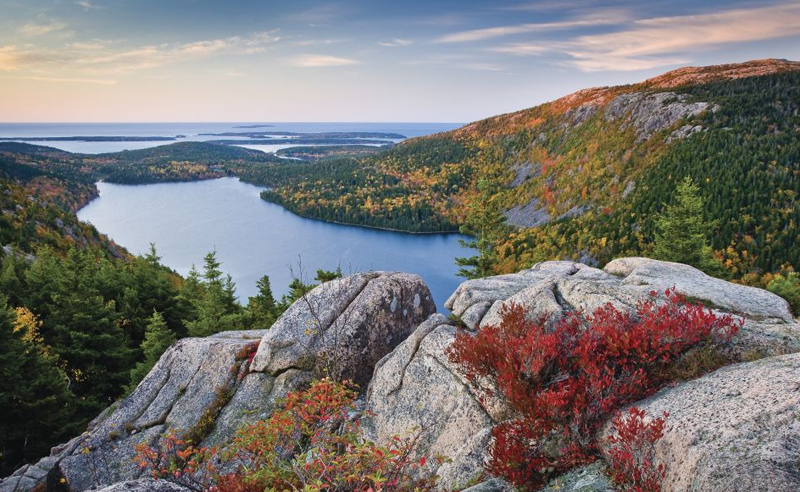Acadia National Park, USA travel tips
Category
Categories
Popular Articles

**Overview of the Destination**
Acadia National Park, located in the U.S. state of Maine, is famous for its breathtaking natural beauty. Sprawling over 49,000 acres, Acadia is known for its diverse landscape – from rugged coastlines, mountains, lakes to dense forests. The park’s standout feature is Mount Desert Island, the largest island off the coast of Maine. The Cadillac Mountain. Here, a sunrise or a sunset is truly a sight to behold. This destination is a haven for outdoor enthusiasts offering various activities such as hiking, biking, wildlife viewing, and much more. It’s also one of the top bird-watching areas in the country.
**Best Time to Visit**
The best time to visit Acadia National Park is on either side of the summer peak: from April to June and September to October. Late spring offers mild temperatures and fewer crowds, while the fall color display in Acadia is absolutely stunning. It does get busier during the summer months, but the weather is also warmest and all park facilities and services are in operation. Major events worth planning around include the Night Sky Festival in September, when you can experience some of the starriest skies in the northeast due to the park’s low light pollution.
**Climate & What to Pack**
Acadia’s climate is moderate and can be unpredictable, so it’s wise to pack for all weather. Summers are warm but occasionally hit the 90s (Fahrenheit). Winters are cold, with temperatures often well below freezing, and the Park is renowned for its colorful fall foliage. Bring a good pair of hiking boots, a rain jacket, lots of layers for the cooler evenings, sunblock, and a hat. Don’t forget a sturdy backpack for your outdoor adventure!
**Getting There**
The nearest major airport to Acadia National Park is Bangor International Airport. From the airport, it’s an approximately one-hour drive to the park. Alternatively, you can fly into Portland International Jetport which is roughly three hours away. Car rentals are readily available at these airports. No visa or special entry requirements are required for U.S. citizens, but international visitors will need to have their documents in order.
**Getting Around Locally**
The park is well serviced by the fare-free Island Explorer Shuttle Bus, which covers most of the park and nearby towns during summer months. Bikes are also for hire and make a great way to see the park, though some areas may be tough for beginners due to rugged terrain. Renting a car gives you the most flexibility. Walking trails are abundant, well marked, and varied in difficulty.
**Safety Tips**
Acadia National Park is generally a safe destination. However, stick to designated trails as the park’s terrain can be challenging and it’s easy to get lost. Be aware of wildlife; it’s best to admire these creatures from a distance, never feed them. Familiarize yourself with the leave no trace principles before your visit and respect local guidelines and regulations.
**Top Things to Do & See**
Must-do activities include watching the sunrise from Cadillac Mountain, exploring the rocky shores and sandy beach of Sand Beach, hiking The Precipice Trail, and driving or biking the 27-mile Park Loop Road. Don’t miss the picturesque Bass Harbor Head Lighthouse and Jordan Pond House for the best popovers (a local pastry) in New England.
**Where to Stay**
For luxury accommodation, the Bar Harbor Inn and Spa offer sea views and excellent service. Midrange options include Acadia Hotel-Downtown or the Castlemaine Inn. For budget-conscious travelers, the Acadia National Park campgrounds are a great way to connect with nature. Bar Harbor makes a convenient base, with lots of dining and shopping opportunities.
**Food & Local Cuisine**
Maine is known for its seafood, so a lobster roll is a must-try, as is local clams, and fresh blueberries if you’re visiting in summer. Dining options range from elegant inns to cute cafes and waterfront eateries in nearby Bar Harbor.
**Cultural & Practical Tips**
The local currency is the U.S. dollar, and while most places accept cards, it’s good to have some cash handy for small vendors. Taxes are not included in the listed prices. People speak English and American-style plugs with two flat pins are used. Free Wi-Fi can be found in most accommodations, and some restaurants and cafes.
**Sustainable or Responsible Travel Tips**
Respect the natural environment by staying on trails, respecting wildlife, and not feeding animals. Carry a reusable water bottle to reduce plastic usage. Always leave no trace and carry out all your trash. The park endorses dark sky practices, so use red-filtered flashlights at night to preserve the stargazing experience for everyone.
**Personal Tips**
For your first visit, it’s worthwhile to stop at the Hulls Cove Visitor Centre for comprehensive park information, maps, and the latest updates on trail conditions. Taking a guided tour with a ranger adds a layer of understanding about the park’s rich biodiversity and history. Remember, Acadia is a place to disconnect, so take your time to explore, relax and truly soak in the beauty of the natural world around you.










